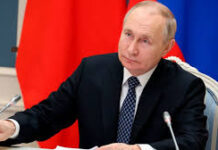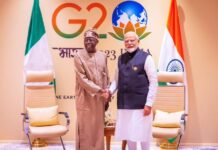How Two Nations Can Be A Beacon of Freedom for the World
By Adam Borowski
In 2016, I had the opportunity to work in China and ended up in Chengdu. That’s where I learned about Chiang Kai-shek’s retreat to Taiwan, and the story sparked my interest in Formosa.
As a Pole, I am acutely aware of Taiwan’s precarious geopolitical position. The ever-present threat of foreign invasion has shaped the Polish mentality. Communist China denies Taiwan statehood, just as Russia sometimes denies Polish statehood.
Taiwan is a shining example of a free society, while China is an egregious example of a surveillance state. Ironically, though not surprisingly, fanatical communists often live in the West. They have no idea what people living in communist countries are going through, and they wouldn’t last a day in North Korea.
Russia and China have a similar mentality. Both countries want to impose their will on other nations, only their methods differ. They laugh at human rights, are collectivist, and hierarchical.
Russia is unapologetically aggressive, while the Chinese Communist Party (CCP) wants to project an image of restraint and neutrality. Luckily, the world sees through the facade.
Ukrainian refugees — mostly women and children — have integrated into Polish society with ease. It’s hardly surprising, as Ukrainians are culturally close to us and many Ukrainians speak Polish without a foreign accent.
Country cousins
We sometimes call Ukrainians our cousins. Sure, we weren’t always on good terms. In fact, there were brutal chapters in Polish-Ukrainian history. We remember the past and look forward to the future, hoping not to repeat the mistakes of the past.
Poland has been accused of Russophobia countless times by the West. Now, the world is finally listening. Russia has dropped the mask of civility. There is a reason why Poland is helping the Ukrainian refugees so much, as we understand what it means to be targeted by merciless regimes hellbent on genocide.
Deportations to Siberia, enforced Russification, rape and torture. That was the picture of the Soviet ‘’liberation’’ in September 1939. Sounds familiar? It should. The same is happening in Ukraine today. Totalitarianism always brings death and destruction, and communism is the worst kind of totalitarianism, as the Taiwanese know all too well.
Russia, even more so than Germany, has always been a problem for Poland. Poland was wiped off the map for 123 years by the Habsburg monarchy, the Kingdom of Prussia and the Russian Empire. As you can see, Russia is always there, plotting to destroy Poland.
The disappearance of Poland reverberated around the world, serving as a warning to others. In a twist of fate, Poland and Japan have allied against Russia. Polish orphans were saved from Siberia by Japan in 1920. The tragic fate of Poland made an impact on Japan.
Read Also:
Take ‘’Porando Kaiko’’ as an example. It was a Japanese soldier’s song popular until 1945. The song warned Japan against complacency and ending up partitioned and humiliated like Poland. The Polish nation briefly regained independence in 1918, only to be destroyed by the Nazi-Soviet invasion in September 1939.
It is no surprise that genocide and enslavement feature prominently in Polish art. One of the most famous Polish paintings is titled ‘’Polonia’’ by Jan Matejko. “Polonia” shows Russian soldiers who are watching a blacksmith placing shackles on a woman. The worried woman in the painting is Poland.
Brutal enslavement
The painting captures the calamitous moment of Poland’s enslavement by Russia. Some of you might say that enslavement is a harsh word, but that is exactly what it was.
Given our tragically complex history, the Poles are a nation of refugees. We understand what Ukrainians are going through. During World War II, Polish refugees were welcomed by Iran and India. Polish Jews prospered in Shanghai.
On a positive note, there are chapters in Polish-Russian history to be proud of. The Polish-Lithuanian Commonwealth occupied Moscow between 1610 and 1612. Emilia Plater, a Polish countess, fought on horseback against the Russian Empire in 1831. Poland stopped the Bolsheviks in 1920 from conquering Europe.
And who could forget Lech Walesa? Let these chapters of Polish history be a reminder that persistence and patriotism can defeat even the most powerful enemy.
On May 3, we were marking the 231st Constitution Day of the Republic of Poland. It is the world’s second modern constitution, after the United States. As the Director of the Polish Office in Taipei, Cyryl Kozaczewski, said:
‘’Poles and Taiwanese value solidarity and mutual support in difficult moments, as best evidenced by our joint efforts to tackle the pandemic outbreak and provide humanitarian aid to Ukraine and Ukrainian refugees in Poland.”
Destined to be allies
Clearly, our two nations are destined to be allies. Taiwan and Poland can be beacons of freedom for the world, showing how nations can prosper economically and culturally, even when the neighboring countries are regimes with imperial ambitions.
While international relations need to be carefully watched, it’s vital to monitor domestic politics as well. It’s no secret that the scourge of totalitarianism can insidiously attack from within.
In a sense, Taiwan and Poland have been blessed with the awareness of how precious freedom is. Many nations across the world lack this awareness and take their independence for granted. Yet, as the Ukraine war shows, any nation can be targeted by a genocidal regime for so-called liberation.
I hope the day the CCP invades Taiwan never comes, but as the war in Ukraine shows, wishful thinking rarely reflects reality.
I look forward to visiting Taiwan and trying its world-famous food, as well as learning about Taiwanese folklore, tales, and traditions.
Adam Borowski is a technical translator living in Warsaw, Poland. He has honed his translation skills at the Polish Ministry of Foreign Affairs and has written 62 articles for the Korea Times, plus a yet-to-be-published novel set in an alternate reality, ‘’Euthanizers.’’ He can be reached at: [email protected]















